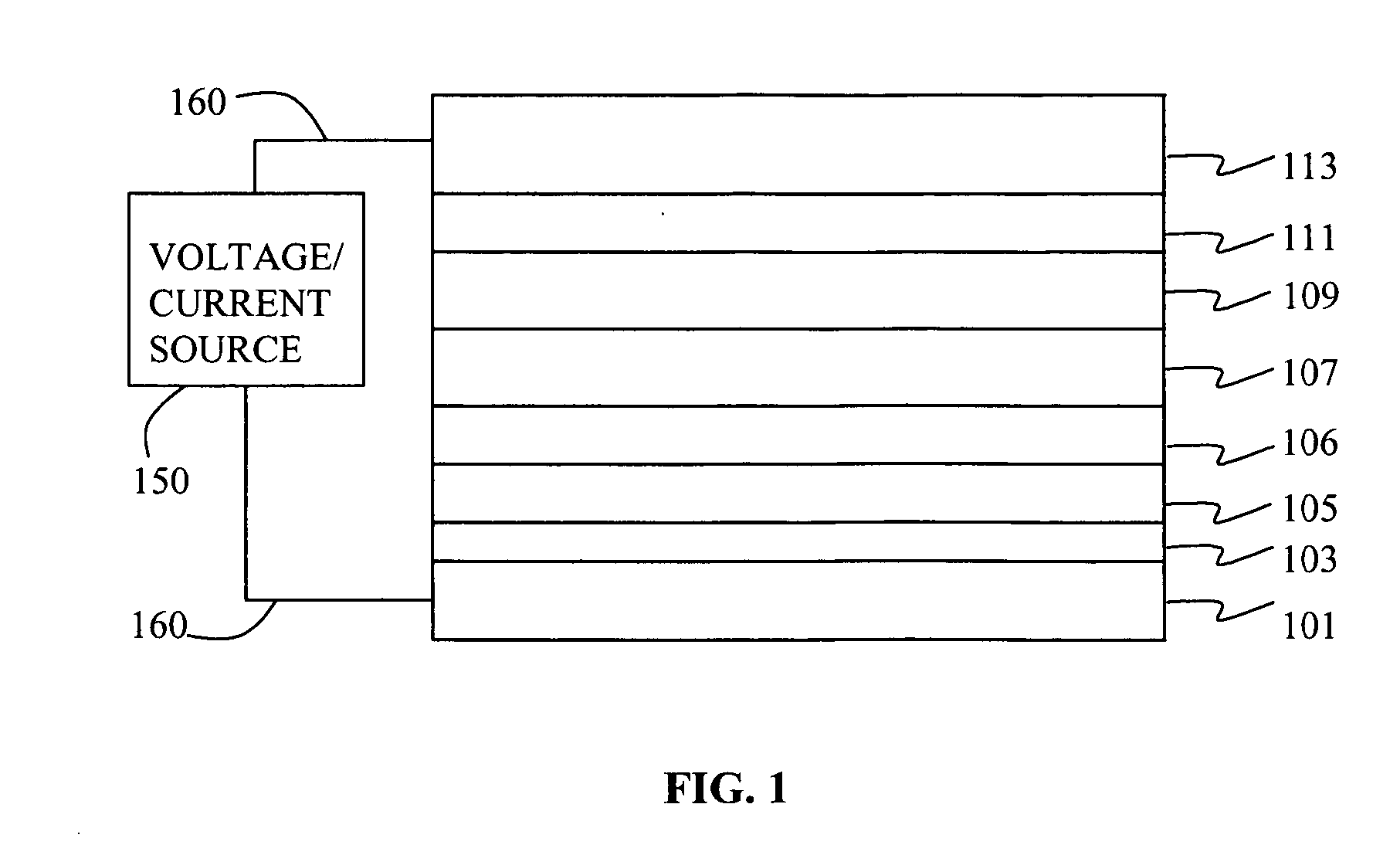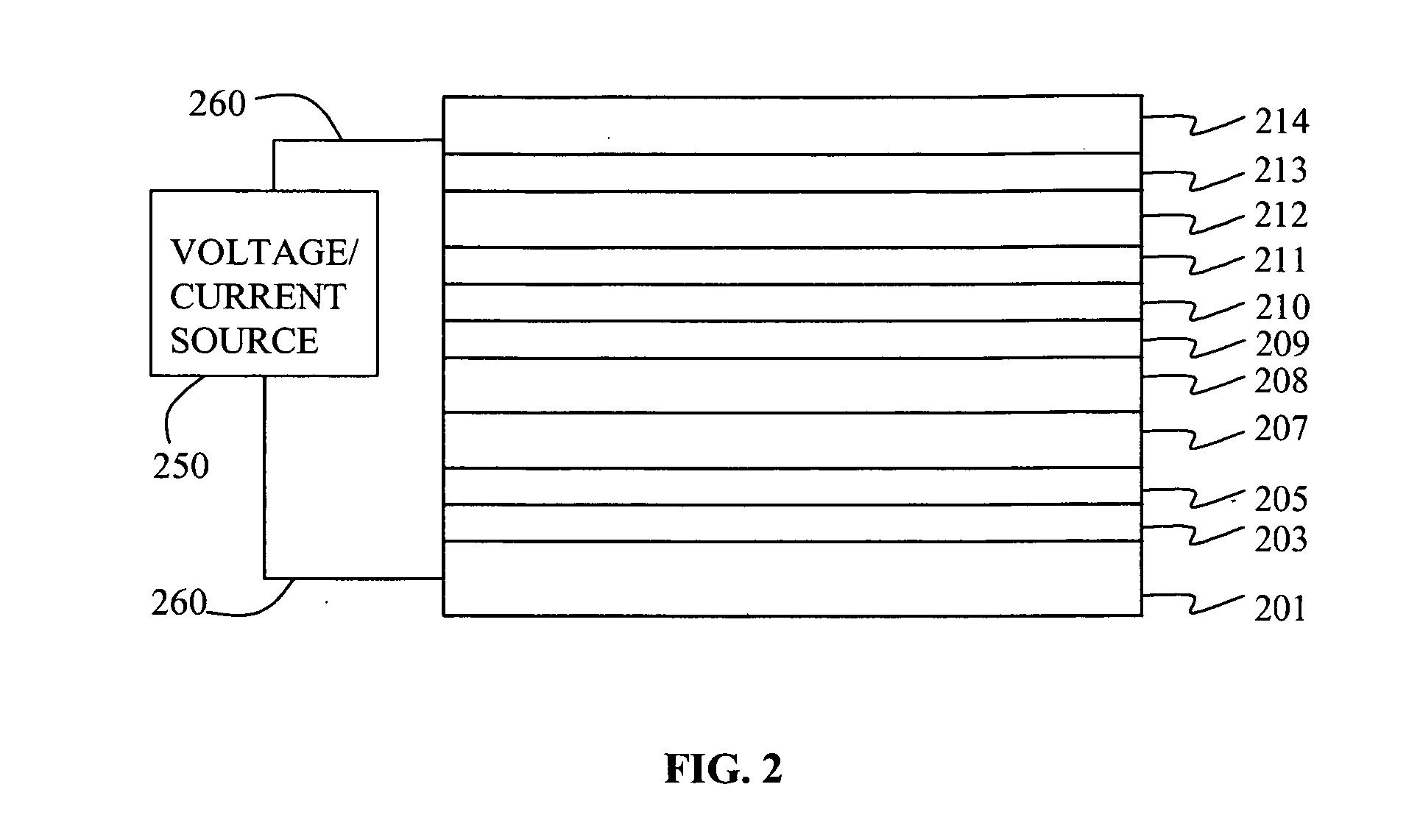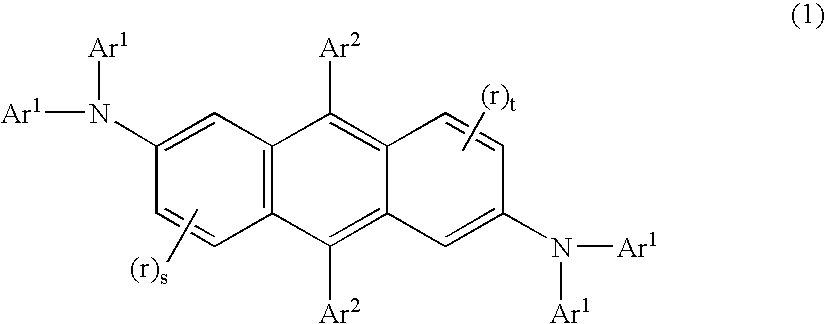Electroluminescent device containing an anthracene derivative
an anthracene derivative and electroluminescent device technology, applied in the direction of discharge tube luminescnet screens, natural mineral layered products, transportation and packaging, etc., can solve the problems of low oxidation potential, low voltage and high luminance, and performance limitations that have been a barrier to many desirable applications, etc., to achieve low voltage, good stability, and high luminance
- Summary
- Abstract
- Description
- Claims
- Application Information
AI Technical Summary
Benefits of technology
Problems solved by technology
Method used
Image
Examples
example 1
Synthesis of Inv-1, N,N,N′,N′, 9,10-hexaphenyl-2,6-anthracenediamine.
[0217]
[0218] 10 Inv-1, N,N,N′,N′, 9,10-hexaphenyl-2,6-anthracenediamine, was prepared according to equation 1- equation 3. Under a nitrogen atmosphere 2,6-dibromoanthraquinone (44 g, 0.12 mol), diphenylamine (42.5 g, 0.26 mol), sodium tert-butoxide (27 g, 0.27 mol), palladium(II) acetate (1.5 g, 0.007 mol), and 400 ml of toluene were added together. With stirring, tri-tert-butylphosphine (1.1 g, 0.005 mol) was added and the reaction was heated at 90 ° C. for 12 hours. Upon cooling, the reaction mixture was passed through a pad of silica gel, eluting with CH2Cl2. Solvents were removed and the crude solid was further purified by chromatography to yield 48.9 g (75% yield) of N,N,N′,N′-tetraphenyl-2,6-diamino-9,10-anthracenedione (Int-1, eq. 1) as a red solid. FD-MS (m / z): 542 Compound (Int-1) (20 g, 0.036 moles) and 200 ml anhydrous tetrahydrofuran (THF) were placed under nitrogen and cooled to −78° C. with stirring....
example 2
Synthesis of N,N,N′,N′-tetrakis(4-methylphenyl)-9,10-diphenyl-2,6-anthracenediamine (Inv-3).
[0220] Under a nitrogen atmosphere 2,6-dibromoanthraquinone (5 g, 13.7 mmol), di-tolylamine (5.6 g, 28.4 mmol), sodium tert-butoxide (3.1 g, 32.2 mmol), palladium(II) acetate (0.17 g, 0.75 mmol), and 50 ml of toluene were added together. With stirring, tri-tert-butylphosphine (0.13 g, 0.64 mmol) was added and the reaction was heated at 90 ° C. for 12 hours. Upon cooling, the reaction mixture was passed through pad of silica gel, eluting with CH2Cl2. Solvents were removed and the crude solid was further purified by chromatography to yield 5.0 g (61% yield) of N,N,N′,N′-tetrakis(4-methylphenyl)-2,6-diamino-9,10-anthracenedione as a red solid. FD-MS (m / z): 598
[0221] N,N,N′,N′-tetrakis(4-methylphenyl)-2,6-diamino-9,10-anthracenedione (2.5 g, 41.8 mmol) and 50 ml anhydrous THF were placed under nitrogen and cooled to -78° C. with stirring. Phenyllithium (1.8 M in cyclohexane:ether [70:30], 6.0 m...
example 4
Synthesis of N,N,N′,N′,N″,N″,N′″,N′″-octaphenyl-2,6,9,10-tetraaminoanthracene (Inv-23).
[0226] Inv-23 was prepared according to equation 4. Under a nitrogen atmosphere 2,6,9,10-tetrabromoanthracene (1.5 g, 3.0 mmol), diphenylamine (2.57 g, 15.2 mmol), sodium tert-butoxide (1.63 g, 16.3 mrnol), palladium(II) acetate (90 mg, 0.4 mmol), and 25 ml of toluene were added together. With stirring, tri-tert-butylphosphine (67 mg, 0.3 mmol) was added and the reaction was heated at 90° C. for 12 hours. Upon cooling, the reaction mixture was passed through a pad of silica gel, eluting with CH2Cl2. Solvents were removed and the crude solid was further purified by chromatography to yield 1.1 g (43% yield) of N,N,N′,N′,N″,N″,N′″,N′″-octaphenyl-2,6,9,10-tetraaminoanthracene (Inv-23) as a red solid. FD-MS (m / z): 846
PUM
| Property | Measurement | Unit |
|---|---|---|
| Electric potential / voltage | aaaaa | aaaaa |
| Electric potential / voltage | aaaaa | aaaaa |
| Electric potential / voltage | aaaaa | aaaaa |
Abstract
Description
Claims
Application Information
 Login to View More
Login to View More - R&D
- Intellectual Property
- Life Sciences
- Materials
- Tech Scout
- Unparalleled Data Quality
- Higher Quality Content
- 60% Fewer Hallucinations
Browse by: Latest US Patents, China's latest patents, Technical Efficacy Thesaurus, Application Domain, Technology Topic, Popular Technical Reports.
© 2025 PatSnap. All rights reserved.Legal|Privacy policy|Modern Slavery Act Transparency Statement|Sitemap|About US| Contact US: help@patsnap.com



